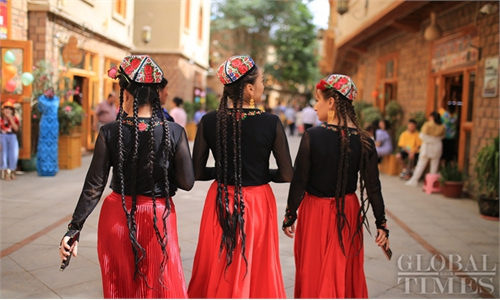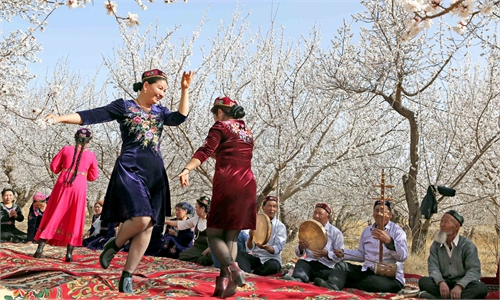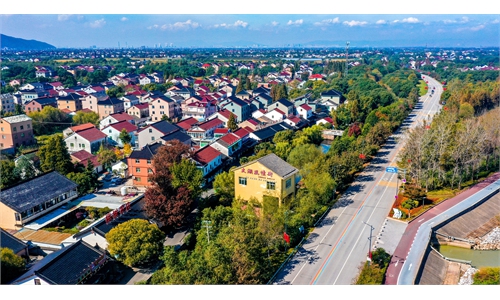IN-DEPTH / IN-DEPTH
Photographers’ work through decades shows Xinjiang's transformation and residents’ improving livelihoods
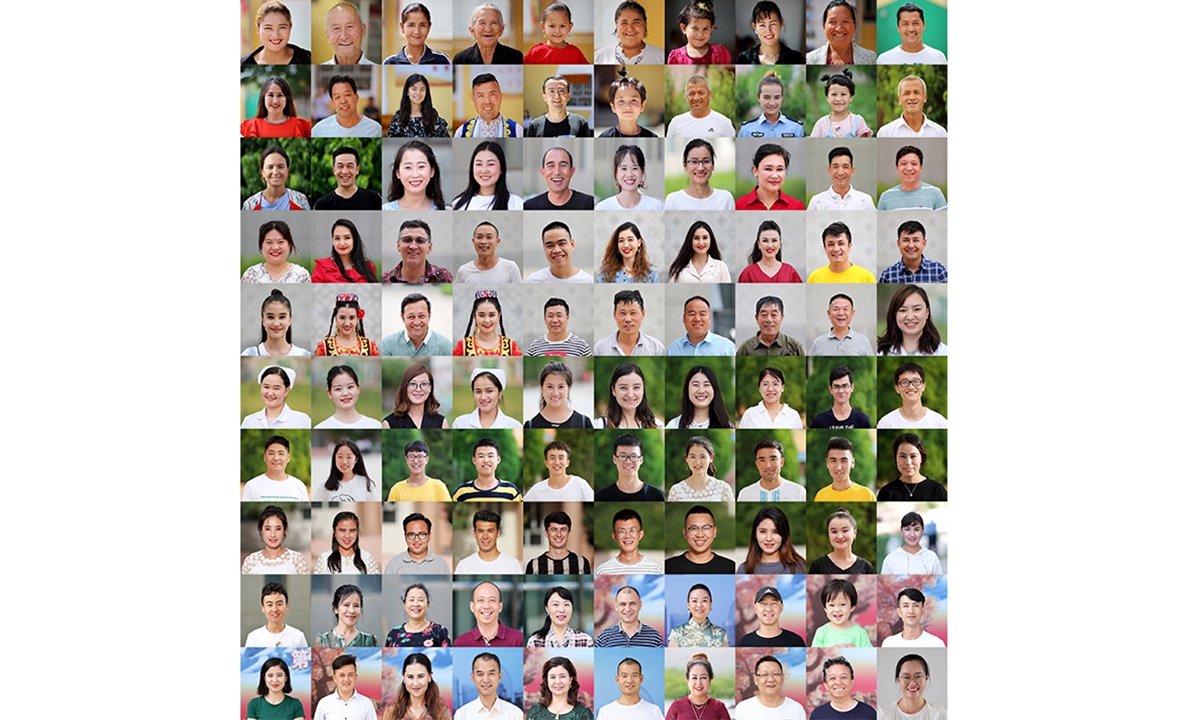
A combination of photos shows Hotan residents' 100 smiling faces Photo: Adili Nadir
When talking about the development of Northwest China's Xinjiang Uygur Autonomous Region, especially in the past decade, people usually produce a string of figures, either on the fast GDP and individual income growth, or its success as a thriving cultural melting pot; there is also another way to more vividly appreciate the prosperity of the region - through the power of image. The Global Times reporters Liu Xin and Bai Yunyi talked with two photographers from Urumqi and Hotan, who shared their photography works and their stories of how these photos captured the region's changes and the happy lives of local residents.
An epitome of development
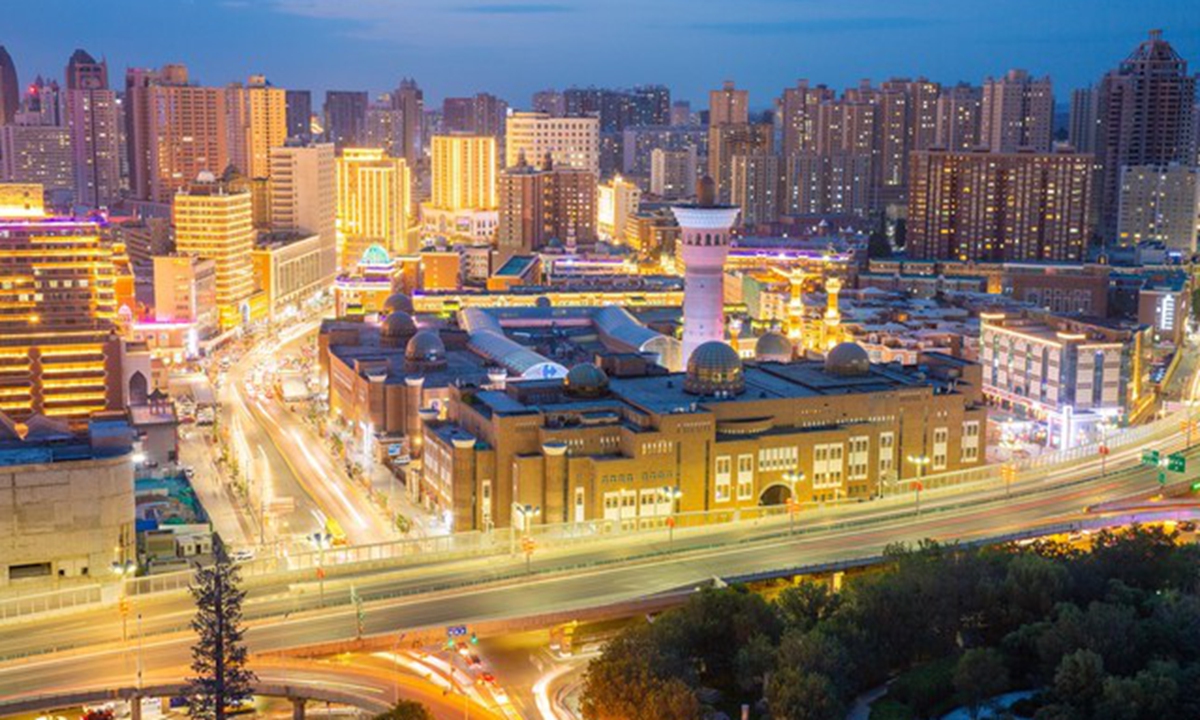
A night view of Xinjiang International Grand Bazzar in Urumqi. Photo: IC
When Li Xiangdong, a resident in Urumqi, decided to pick up the camera and take architectural photographs of the city in 1982, it did not occur to him that he would become a regional historian for over 40 years.Since the 1980s, Li has successively worked in the publicity departments of two construction companies and later at the Xinjiang Architectural Design Institute, to take photos of construction projects for the assessment of progress.
However, after witnessing how blueprints turned into high-rise edifices in real life, Li came up with the idea of using the camera to capture images of landmark buildings in Urumqi, including the People's Hall of Xinjiang, the Overseas Hotel, and the South Railway Station - touring around the city on a bicycle.
Along with the construction of various buildings was Xinjiang's social and economic development. According to a white paper released by the Information Office of the State Council in October 2009, after the 1970s and the reform and opening-up, Xinjiang entered into a period of rapid socio-economic development with residents from all ethnic groups sharing in the region's windfall.
"When I began taking photos, there were few tall buildings in Urumqi - the eight-floor Kunlun Hotel built in 1959 was the highest landmark in the city," Li told the Global Times. It was only until 1983 when the nine-floor Xinjiang Hotel replaced Kunlun as the tallest building.
In 1985 when Xinjiang celebrated the 30th anniversary for the founding of the autonomous region, the 13-storey Huaqiao Hotel became the tallest building. In 1988 and 1989, the 19-floor Labor Union Building and 22-floor Xinjiang Holiday Hotel were built one after another.
"At that time, the main district in Urumqi was not large, with many tall buildings clustered along the Guangming and Xinhua roads," Li recalled. "I could complete a ride around the city in half a day."
After the 1990s, high-rises mushroomed across Urumqi. Li also bought a new camera and gained more professional skills in photography to capture larger and clearer images of the city. "Many new buildings at the time were banks and hotels that incorporated more modern architectural designs and some used glass screen walls and steel framed structures," said Li.
"Since 2005 to present-day, changes in Urumqi have occurred at a breakneck speed," said Li, noting that there appeared more residential buildings with excellent living conditions and people's lives were getting better. Some old buildings in the city were replaced by or remolded into more contemporary architectural styles.
"It was also in this period that the city expanded quickly and became one of the large cities in China. It was no longer easy to finish touring the city in half a day. To have a panoramic view of it, I would need to climb the 1,300-meter Yamalike Mountain," said Li.
Behind the construction boom reflected Xinjiang's economic and social development. The region's GDP in 2008 hit 420.3 billion yuan, 86.4 times that of 1952 and 19.6 times that of 1978, according to the white paper published in 2009. After the 18th?National?Congress of the Communist Party of China in 2012, Xinjiang continued to embrace booming development. Its GDP surpassed 600 billion yuan in 2011 and in 2021, the number stood at over 1.598 trillion yuan.
Residents' average income also increased. According to data from the Xinjiang government, the average income of urban and rural residents in the region in 1978 was 319 yuan and 119 yuan respectively, while in 2018, the numbers had grown to 32,764 yuan and 11,975 yuan.
All these developments in the past four decades have been captured by Li in his pictures. He told the Global Times that photos of Urumqi at night were his favorite as they "are the epitome of the city and the region's developments."
"The first photo was taken on the night of the National Day in 1985 - it was also the day when Xinjiang celebrated the 30th anniversary of the founding of the region. I went to the just-finished Huaqiao Hotel and took a photo of the fireworks display. At that time, the night lights were ordinary incandescent light bulbs and decorated the main streets. Other areas of the city were dark, therefore many of my pictures were dark. But I was still deeply impressed by that night and thought Urumqi was never so fabulous and bright," said Li.
"In 1994, I took a new photo of Urumqi by night. I came up with the idea to record all the excellent views of the city in one picture. At that time, we had no computers and could not merge different pictures together. So I used multiple exposure camera functions and went to several sites, taking photos in a way that would allow them all appear in the same frame," said Li.
"Then on the night of the 70th anniversary of the founding of the People's Republic of China in 2019, I took photos of the city by using an unmanned aerial vehicle," Li said, recalling that Urumqi "was such a sleepless city" and was immersed in gorgeous and bright lights.
"I couldn't find a proper word to describe the view except 'fabulous' or 'gorgeous.' The photos that were taken in 1980s had nothing to rival such a view," said Li.
The 68-year-old resident in Urumqi also told the Global Times that when he first picked up the camera, he did not intend to become such a static image historian, but "I now love the city more. Its changes are also epitomes of China's development in the past decades. I wish to record more changes of the city for as long as I am around. I hope to see the city progress more and to take more colorful photos in the future."
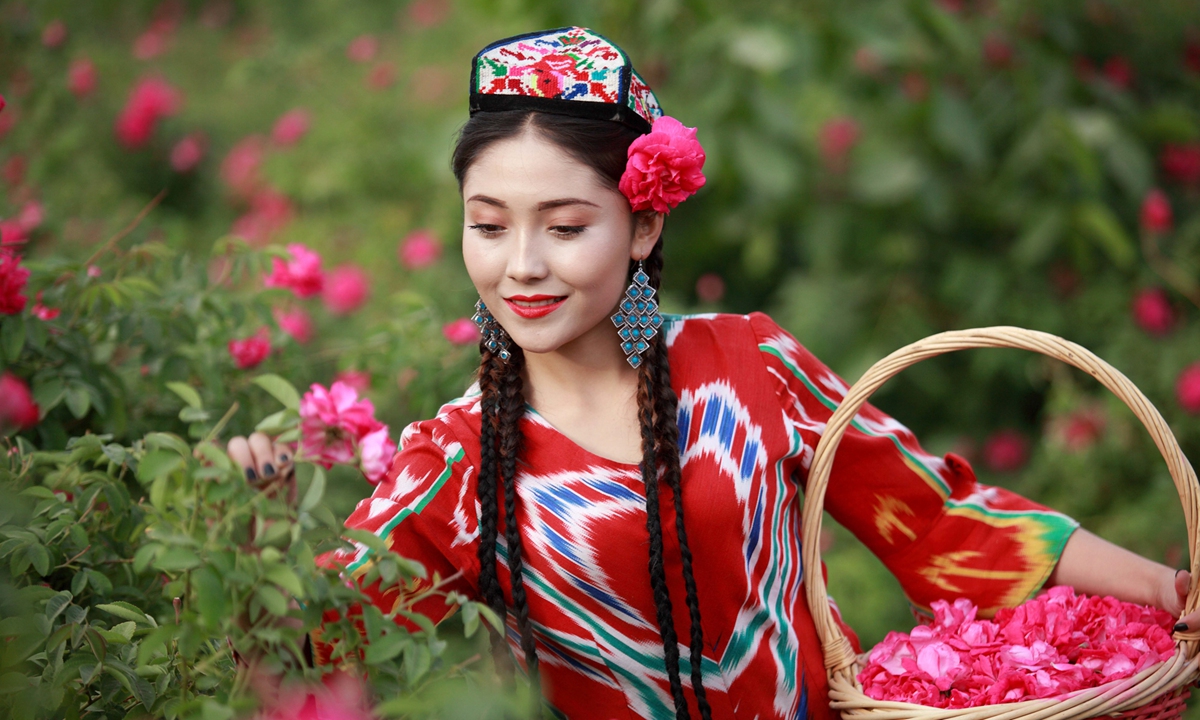
A Uygur woman from Hotan Prefecture picks flowers. Photo: Adili Nadir
Colorful, spirited, fashionable
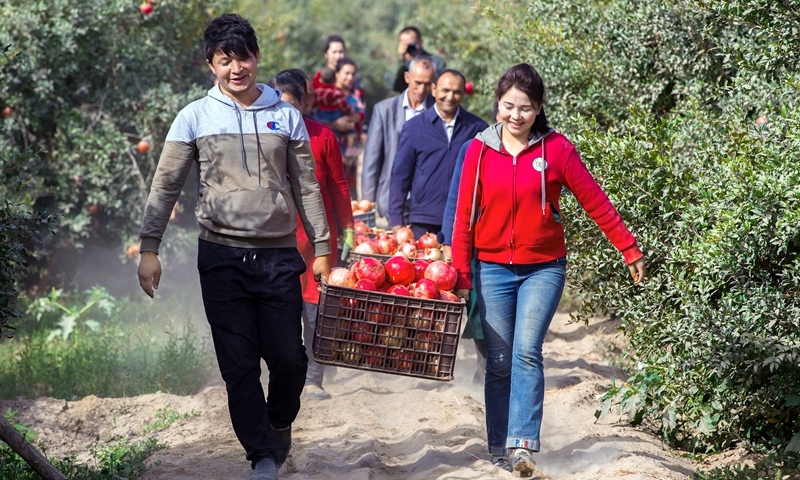
Pishan county residents harvest pomegranates. Photo: Adili Nadir
Adili Nadir from Hotan Prefecture has focused more on the people's lives in his photography works, showing a colorful, lively and vivid Xinjiang - the fresh oven-baked samsa in the bazzar, the enduring populus in southern Xinjiang, smiling women busy making nan bread, boisterous weddings - the prosperity of the city and the lives of the residents therein have been eternally captured in images.Since 2002, Adili has visited almost all the villages and counties in the prefecture to take pictures of the scenery and capture the rituals and local residents' daily lives.
He told the Global Times "I started to take pictures as a hobby but the more places I visit, the more responsibility I have felt - I want to record everything that happens in my hometown and I want to let more people outside of Xinjiang to know how our lives are. I want more people to love this land - the westernmost land in our country - through my photos."
For Adili, the changes in his hometown and the Xinjiang region as a whole in the past 10 years are "earthshatting." "I like going to the bazaars very much. Ten years ago, I could only take some photos of food and people around lacked vibrancy, with women fully covering their faces. But now, the bazars are colorful, the residents are in good spirits, and women wear fashionable and beautiful cloths," said Adili.
Aside from being a photographer, Adili is also a "first secretary" of a village in Hotan, and this identity has made him more aware of the changes in rural areas in the region. "Since 2021 when I came back to the village to take on the role of the first secretary, I was shocked by the overall changes in residents' lives and the achievements made in poverty alleviation," he said.
Adili decided to use a camera to record these changes. "One of my favorite photos was taken in Piyaliema town in Pishan county when local residents were harvesting pomegranates - a young man and a girl are carrying a box of pomegranates with satisfactory smiles on their faces. Another photo was taken in a factory where nan is produced in large quantity. Both photos have distinct Xinjiang characteristics and show the change of the times."
Adili has also captured the smiles of 100 local residents - they are workers, officials, students, farmers, and so on. "You can see that all their smiles are different and each smile is sincere," he told the Global Times.
Adili said he now has a new plan. "I want to use my leisure time to take more photos of the sceneries in Hotan because I want more people to see the fabulous landscape at the foot of the Kunlun Mountain. I am also working on another project - taking a family photo of each household in my village."
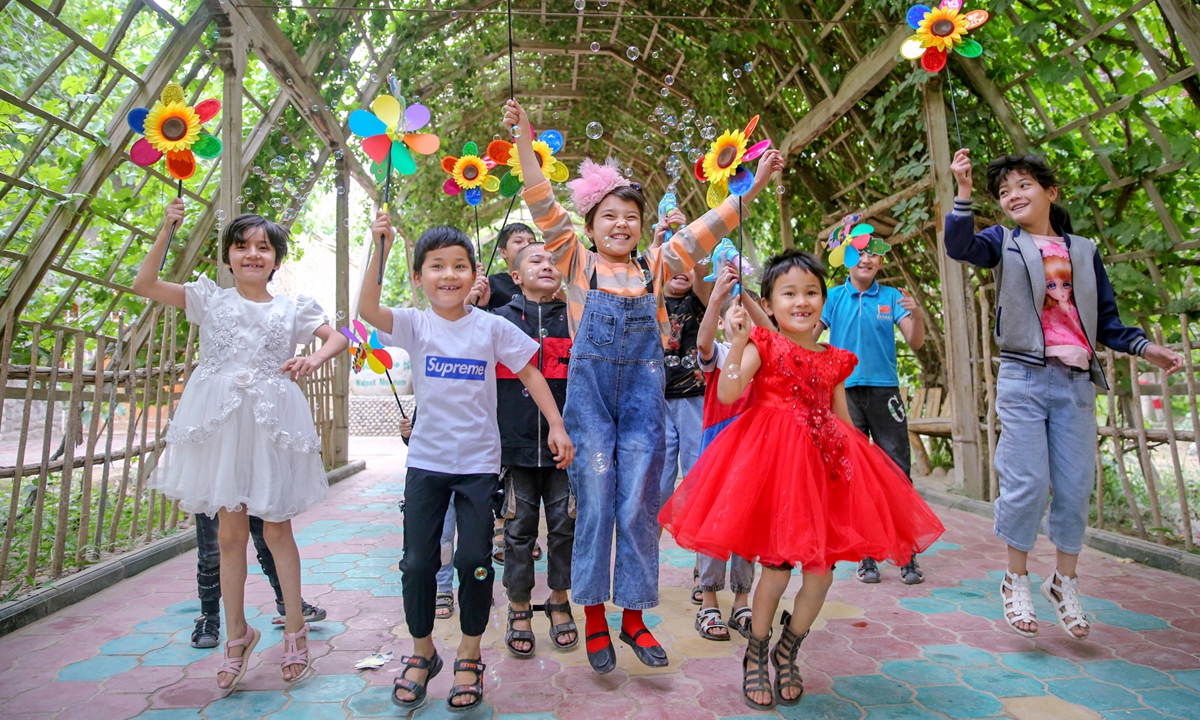
Children in Hotan Prefecture Photo: Adili Nadir
"For me, the family photo shows the harmony of a family and each family is one cell unit of the society," Adili said that "as a photographer, I may not do too many things, but taking pictures of the residents and recording their happy lives to add some joy to them is my humble wish."
